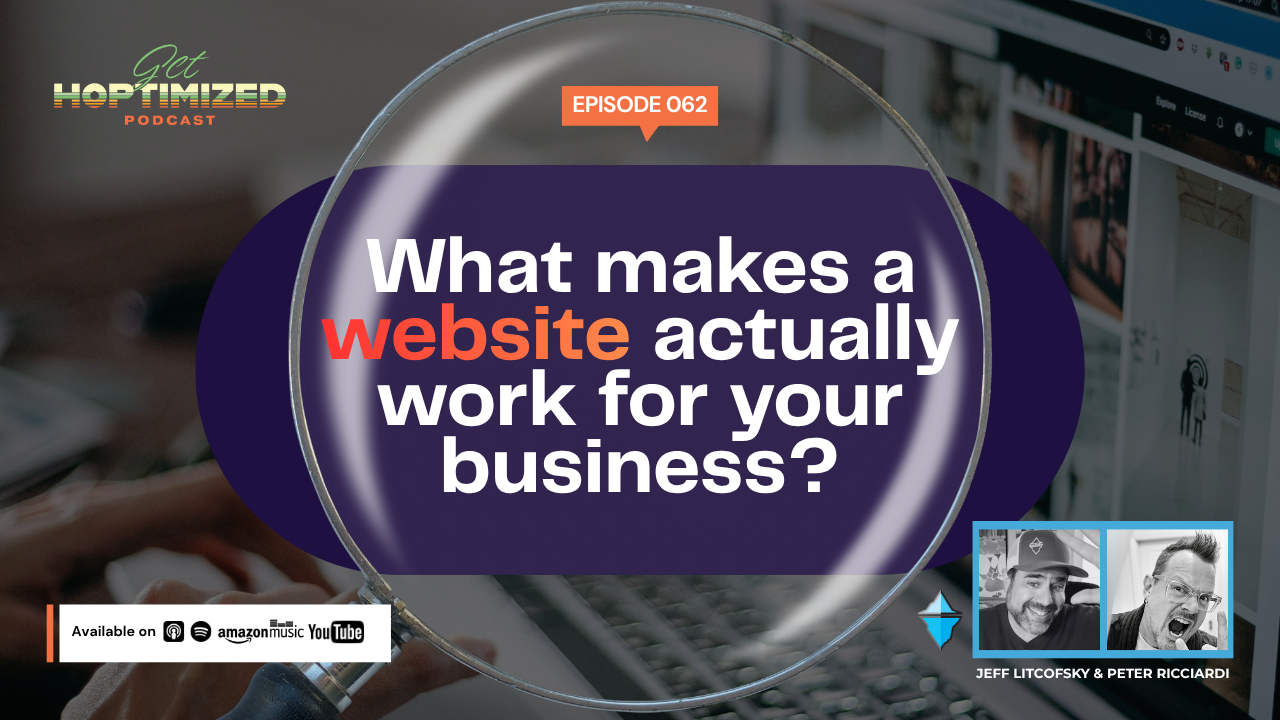What Makes a Website Actually Work for Your Business with Jeff and Peter from Brandartica
Episode Overview
In episode 62 of the Get Hoptimized Podcast, we dive into what truly makes a website work. Jeff and Peter from Brandartica, a branding and web development agency, discussed the critical role of a website in a business's digital marketing ecosystem.
If you're ready to develop a website that scales with your growth, the experts at Brandartica specialize in crafting high-impact branding and web solutions for your business.
-Music Credit-
Neon Drive by Punch Deck | www.soundcloud.com/punch-deck
Music promoted by | www.free-stock-music.com
The Golden Thread: How to Build a Business-Driving Website
In a recent episode of the Get Hoptimized podcast, Chris hosts Jeff, and Peter of the branding and web development agency Brandartica broke down a critical question: What makes a website truly work for your business? The answer goes far beyond aesthetics. It's about a strategic, audience-first approach that ensures every digital touchpoint serves your overarching business goals.
Here are the key takeaways from the conversation, offering a blueprint for transforming your website from a simple online brochure into an essential growth vehicle.
1. The Power of Brand Alignment: The "Golden Thread"
A central concept from Brandartica’s philosophy is the "golden thread"—the absolute necessity of brand consistency across all platforms. A disconnect between your advertising, social media, product packaging, and website can confuse customers and erode trust.
Setting Expectations: Your website must visually and tonally align with any advertisement that drove a customer to it. If the look and feel are off, customers immediately question, "Am I in the right place?"
The Mobile-First Reality: With most traffic coming from mobile devices, the design must prioritize functionality and user experience (UX) on small screens. Your fantastic desktop ideas "won't scale" if they aren't mobile-friendly.
Audience Over Ego: A common mistake is for business owners to design for their own taste. The experts emphasize that the website is for the audience, and the design must cater to their preferences and needs, not the personal favorites of the CEO.
2. Tailoring the Strategy: E-commerce vs. Brick-and-Mortar
The purpose of a website must change depending on whether you are selling products online or driving traffic to a physical location.
For E-commerce businesses (e.g., coffee, consumer goods), the primary objective is to act as a 24/7 retail store and salesperson. This means creating a seamless shopping experience, ensuring excellent merchandising (organized SKUs), and being ready for critical integrations with tools like email marketing (e.g., HubSpot) and sales data systems.
For Brick-and-Mortar businesses (e.g., breweries, restaurants), the goal is to be an information hub that drives in-person visits. Key website functionality must provide the "least friction possible" for customers, including prominently displaying giant phone numbers, clear directions, and parking information. The site must also set an authentic expectation for the physical location. A "gorgeous website" with a poor or dirty in-person establishment is a disconnect that leads to bad reviews. Consistency and attention to detail—from professional food photography to staff alignment—is part of the full customer journey.
3. Beyond the Calendar: Content as a Story
For businesses with physical locations, Peter advises against a bare-looking event calendar, which can signal a lack of activity.
Be Creative: If you only have one event a month, find a more engaging way to display the information (e.g., a simple running scroll or dedicated section) rather than an empty calendar grid.
Tell a Story: Use the website to develop a character and personality for your brand. For a brewery, this might mean telling stories about the ingredients' origins or other cultures, creating an inclusive destination that is an "information hub" of value, not just a place to sell beer.
The Three-Phase Blueprint for Web Projects
To ensure a successful, goal-driven website build, Brandartica follows a structured, three-phase process that reverses the traditional order of operations:
Phase 1: Content First
The team collaborates with the client to create all content and messaging based on the brand identity guide.
This content dictates the structure, ensuring the site is "future-proof" and can scale.
Phase 2: Web Design
The approved content is handed to the designer. They now understand precisely what needs to fit and how it needs to be laid out, moving beyond abstract creative direction.
Phase 3: Web Development
The approved content and design are handed to the developer. This clarity allows the developer to build the website quickly and efficiently without having to wait for last-minute content or design decisions.
Optimize Your Website for Growth
Ultimately, Jeff and Peter underscore that your website is a powerful business tool, but it's only as good as the strategy behind it and the alignment of your entire team. By focusing on audience needs, maintaining brand consistency, and adhering to a structured build process, you can ensure your website is working to grow your business 24/7.
Ready to Build a Website That Actually Works?
The difference between an online brochure and a business-driving asset is a smart, strategic build rooted in brand and audience. If you're ready to create your "golden thread" and develop a website that scales with your growth, the experts at Brandartica specialize in crafting high-impact branding and web solutions for e-commerce and brick-and-mortar businesses.
Contact Brandartica.agency today to start your three-phase brand and web strategy.




